Analysis of Drought and Flood Variations on a 200-Year Scale Based on Historical Environmental Information in Western China
Abstract
:1. Introduction
2. Materials and Methods
2.1. Materials
2.2. Method
3. Results
3.1. Reconstruction of Drought and Flood Sequences
3.2. Variation of Droughts and Floods
4. Discussions
4.1. Droughts and Floods with Precipitation and Human Activities
4.2. Droughts and Floods with ENSO
4.3. Droughts and Floods with Sunspots
5. Conclusions
Author Contributions
Funding
Institutional Review Board Statement
Informed Consent Statement
Data Availability Statement
Conflicts of Interest
References
- Grimaldi, S.; Serinaldi, F. Asymmetric copula in multivariate flood frequency analysis. Adv. Water Resour. 2006, 29, 1155–1168. [Google Scholar] [CrossRef]
- Liu, Y.G.; Wang, N.L.; Zhang, J.H.; Wang, L.G. Climate change and its impacts on mountain glaciers during 1960–2017 in western China. J. Arid Land 2019, 11, 537–550. [Google Scholar] [CrossRef] [Green Version]
- Liu, Y.G.; Zhang, J.H.; Zhao, Y.Q. The Risk Assessment of River Water Pollution Based on a Modified Non-Linear Model. Water 2018, 10, 362. [Google Scholar] [CrossRef] [Green Version]
- Zheng, J.Y.; Ge, Q.S.; Hao, Z.X.; Liu, H.L.; Man, Z.M.; Hou, Y.J.; Fang, X.Q. Paleoclimatology Proxy Recorded in Historical Documents and Method for Reconstruction on Climate Change. Quat. Sci. 2014, 34, 1186–1196. [Google Scholar]
- Liu, Y.G.; Yu, K.K.; Zhao, Y.Q.; Bao, J.C. Impacts of Climatic Variation and Human Activity on Basin Runoff in Western China. Sustainability 2022, 14, 942. [Google Scholar]
- Zheng, J.Y.; Zhang, X.Z.; Liu, Y.; Hao, Z.X. The assessment on hydroclimatic changes of different regions in China at multi-scale during the past millennium. Acta Geogr. Sin. 2020, 75, 1432–1450. [Google Scholar]
- Fang, K.Y.; Frank, D.; Gou, X.H.; Liu, C.Z.; Zhou, F.F.; Li, J.B.; Li, Y.Q. Precipitation over the past four centuries in the Dieshan Mountains as inferred from tree rings: An introduction to an HHT-based method. Glob. Planet. Chang. 2013, 107, 109–118. [Google Scholar] [CrossRef]
- Ge, Q.S.; Zheng, J.Y.; Hao, Z.X.; Zhang, X.Z. State-of-the-arts in the study of climate changes over China for the past 2000 years. Acta Geogr. Sinca 2014, 69, 1248–1258. [Google Scholar]
- Treydte, K.S.; Schleser, G.H.; Helle, G.; David, C.F.; Matthias, W.; Gerald, H.H.; Jan, E. The twentieth century was the wettest period in northern Pakistan over the past millennium. Nature 2006, 440, 1179–1182. [Google Scholar] [CrossRef]
- Watson, T.A.; Barnett, F.A.; Gray, S.T.; Tootle, G.A. Reconstructed Streamflows for the Headwaters of the Wind River, Wyoming, United States. J. Am. Water Resour. Assoc. 2009, 45, 224–236. [Google Scholar] [CrossRef]
- Liu, Y.G.; Guo, Z.M.; Zhou, Q.; Wu, X.B.; He, J.Q. The climate characteristics of the first date of ≤0 °C temperature in East China. Arct. Antarct. Alp. Res. 2015, 47, 83–93. [Google Scholar] [CrossRef] [Green Version]
- Wang, Y.J.; Li, M.Q. Research progress of dry-wet climate reconstruction by tree ring in China. Prog. Geogr. 2016, 35, 1397–1410. [Google Scholar] [CrossRef] [Green Version]
- Liu, Y.G.; Wang, S.X.; Wang, Y.; Hu, H.N. Evaluation of potential evapotranspiration in the Weihe River Basin based on statistical downscaling. IOP Conf. Series: Earth Environ. Sci. 2018, 191, 012025. [Google Scholar] [CrossRef]
- Yin, Z.Y.; Zhu, H.F.; Huang, L.; Shao, X.M. Reconstruction of biological drought conditions during the past 2847 years in an alpine environment of the northeastern Tibetan Plateau, China, and possible linkages to solar forcing. Glob. Planet. Change 2016, 143, 214–227. [Google Scholar] [CrossRef]
- Zhang, D.E.; Liang, Y.Y. A long lasting and extensive drought event over China during 1876–1878. Adv. Clim. Chang. Res. 2010, 6, 106–112. [Google Scholar]
- Zheng, J.Y.; Hao, Z.X.; Fang, X.Q.; Ge, Q.S. Changing characteristics of extreme climate events during past 2000 years in China. Prog. Geogr. 2014, 33, 3–12. [Google Scholar]
- Bai, H.Z.; Dong, A.X.; Zheng, G.F. Atlas of the Drought/Flood Category for Nearly 500 Years in Northwestern China (1470–2008); China Meteorological Press: Beijing, China, 2010. [Google Scholar]
- Zhang, D.E. A compendium of Chinese Meteorological Records of the Last 3 000 Years; Fenghuang Press: Nanjing, China, 2004. [Google Scholar]
- Central Meteorological Bureau of China. Atlas of the Drought/Flood Category for the Last 500 Years in China; Map Press: Beijing, China, 1981. [Google Scholar]
- Wen, K.G. Complete Book of Meteorological Disasters in China (Ningxia Volume); China Meteorological Press: Beijing, China, 2007. [Google Scholar]
- GB/T 20481–2006; The Grade of Meteorological Drought. China Standard Press: Beijing, China, 2006.
- Zhang, D.E.; Li, X.Q.; Liang, Y.Y. Atlas of the drought/flood category for nearly 500 years in China-Continued Supplement (1993–2000). J. Appl. Meteorol. Sci. 2003, 14, 379–389. [Google Scholar] [CrossRef]
- Zhang, D.E. Severe drought events as revealed in the climate records of China and their temperature situations over the last 1000 years. Acta Meteorol. Sin. 2005, 19, 485–491. [Google Scholar]
- Wan, J.H.; Lyu, J.; Liu, H.P.; Liu, J.G.; Yang, Z.Y.; Chen, F.Z. Drought-flood variation characteristics and trends in arid Northwestern China during 1470–2008. Adv. Water Sci. 2014, 25, 625–631. [Google Scholar]
- Huang, S.Z.; Huang, Q.; Wang, Y.M.; Chen, Y.T. Evolution of drought characteristics in the Weihe River Basin based on standardized precipitation index. J. Nat. Disasters 2015, 24, 15–22. [Google Scholar]
- Hu, H.N.; Liu, Y.G.; Ma, K. Characteristics of Drought and Flood in the centennial-scale of the Weihe River Basin and Its Influencing Factors. Bull. Soil Water Conserv. 2020, 40, 255–262. [Google Scholar] [CrossRef]
- Yi, L.; Yu, H.; Ge, J.; Lai, Z.; Xu, X.; Qin, L.; Peng, S. Reconstructions of annual summer precipitation and temperature in north-central China since 1470 AD based on drought/flood index and tree-ring records. Clim. Change 2012, 110, 469–498. [Google Scholar] [CrossRef]
- Tian, Q.H.; Zhou, X.J.; Gou, X.H.; Zhao, P.; Fan, Z.X.; Helama, S. Analysis of reconstructed annual precipitation from tree- rings for the past 500 years in the middle Qilian Mountain. Sci. China Earth Sci. 2012, 55, 770–778. [Google Scholar] [CrossRef]
- Lee, H.F.; Zhang, D.D.; Pei, Q. Reconstruction of the geographic extent of drought anomalies in northwestern China over the last 539 years and its teleconnection with the Pacific Ocean. Holocene 2015, 25, 1271–1284. [Google Scholar] [CrossRef]
- Chen, F.; Zhang, R.B.; Wang, H.Q.; Li, Q. Updated precipitation reconstruction (AD 1482–2012) for Huashan, northcentral China. Theor. Appl. Climatol. 2016, 123, 723–732. [Google Scholar] [CrossRef]
- Lan, Y.C.; Lin, S.; Hu, X.L.; Liu, J.Q. Effect of ENSO cycle on the temperature, precipitation and runoff in Qilian mountainous area, northwestern China. J. Desert Res. 2009, 29, 352–358. [Google Scholar]
- Su, M.; Wang, H. Relationship and its instability of ENSO—Chinese variations in droughts and wet spells. Sci. China Ser. D Earth Sci. 2007, 50, 145–152. [Google Scholar] [CrossRef]
- Liu, Y.G.; Wang, N.L.; Wang, L.G.; Guo, Z.M.; Wu, X.B. Variation of cloud amount over China and the relationship with ENSO from 1951 to 2014. Int. J. Climatol. 2016, 36, 2931–2941. [Google Scholar] [CrossRef]
- De Jager, C. Solar activity and its influence on climate. Netherland J. Geosci.-Geoglogieen Mijnb. 2008, 873, 207–213. [Google Scholar] [CrossRef] [Green Version]
- Zhou, Q.; Chen, W. Impact of the 11-year solar cycle on the relationship between the East Asian winter monsoon and the following summer monsoon and the related processes. Clim. Environ. Res. 2014, 19, 486–496. [Google Scholar]
- Zhao, L.; Wang, J.S.; Zhao, H.J. Solar cycle on dacadal variability in monsoon precipitation over China. J. Meteor. Soc. Japan. 2012, 90, 1–9. [Google Scholar] [CrossRef] [Green Version]
- Zheng, J.Y.; Liu, Y.; Hao, Z.X.; Ge, Q.S. State-of-art and perspective on global synthesis studies of climate change for the past 2000 years. Quat. Sci. 2021, 41, 309–322. [Google Scholar]
- Shi, H.; Wang, B.; Cook, E.R.; Liu, J.; Liu, F. Asian summer precipitationover the past 544 years reconstructed by merging tree rings and historical documentary records. J. Clim. 2018, 31, 7845–7861. [Google Scholar] [CrossRef]

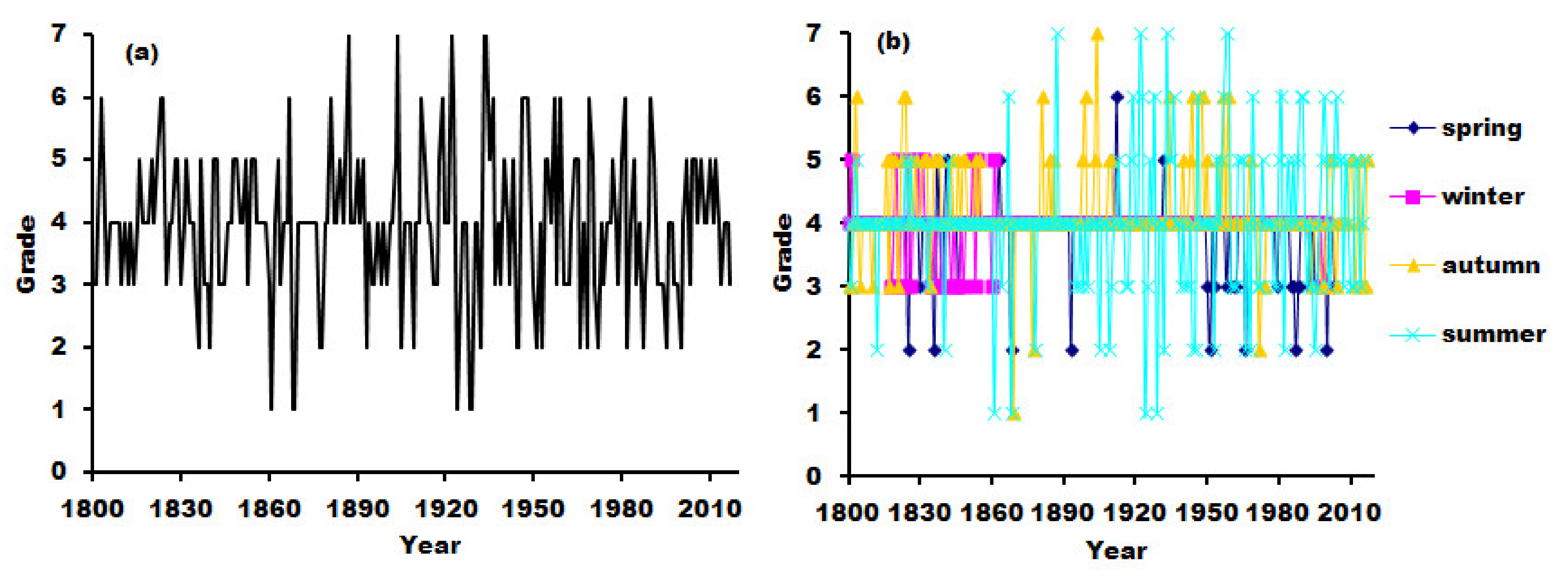
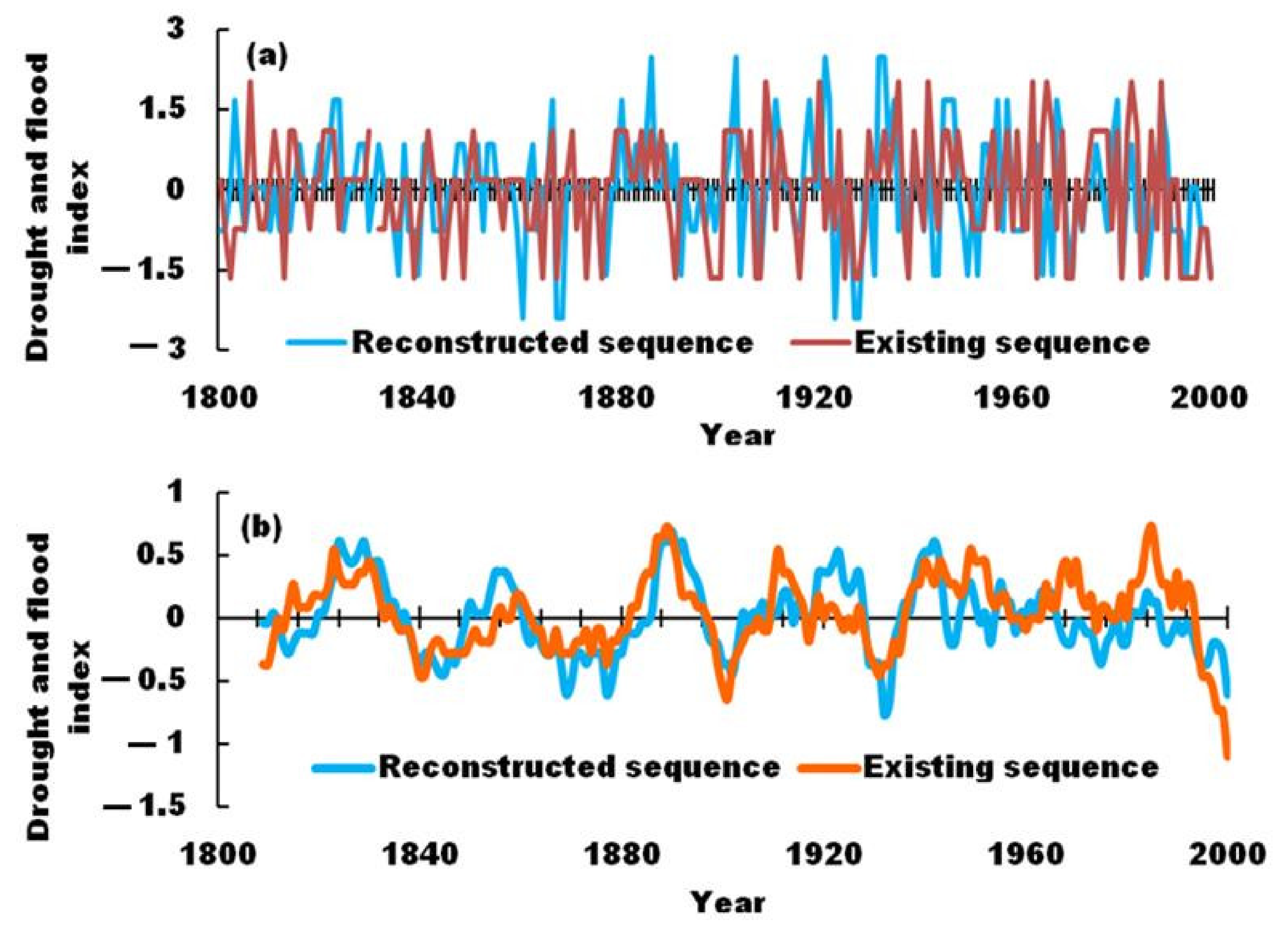
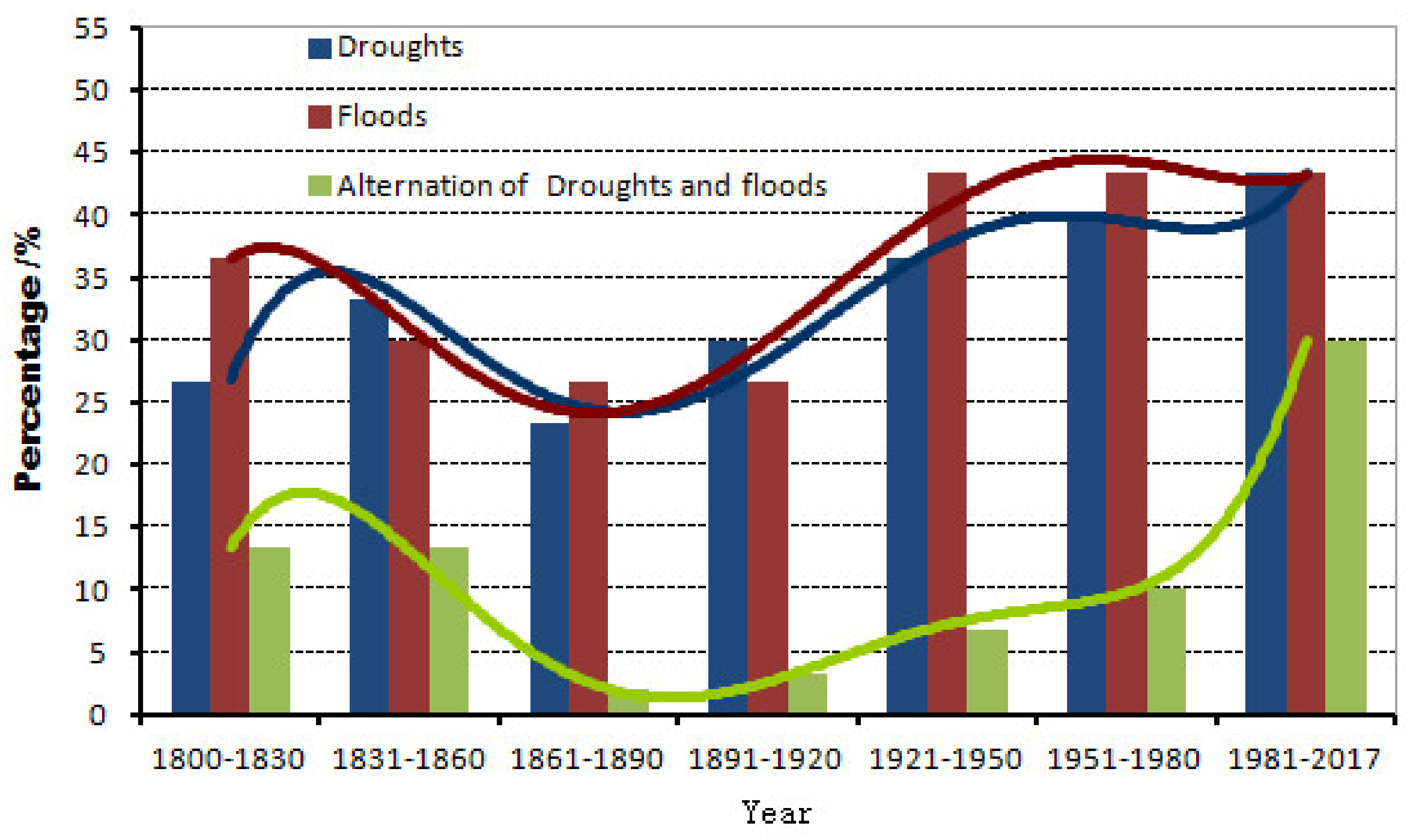
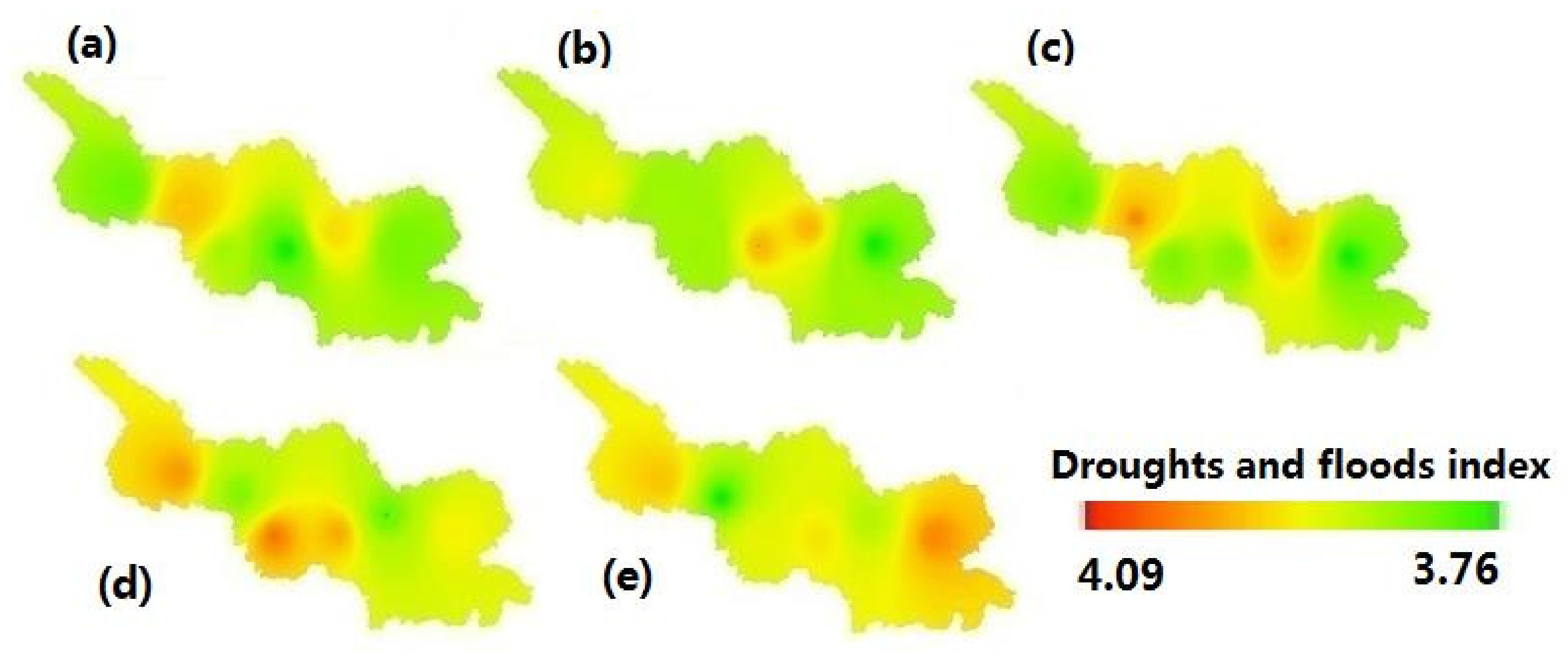
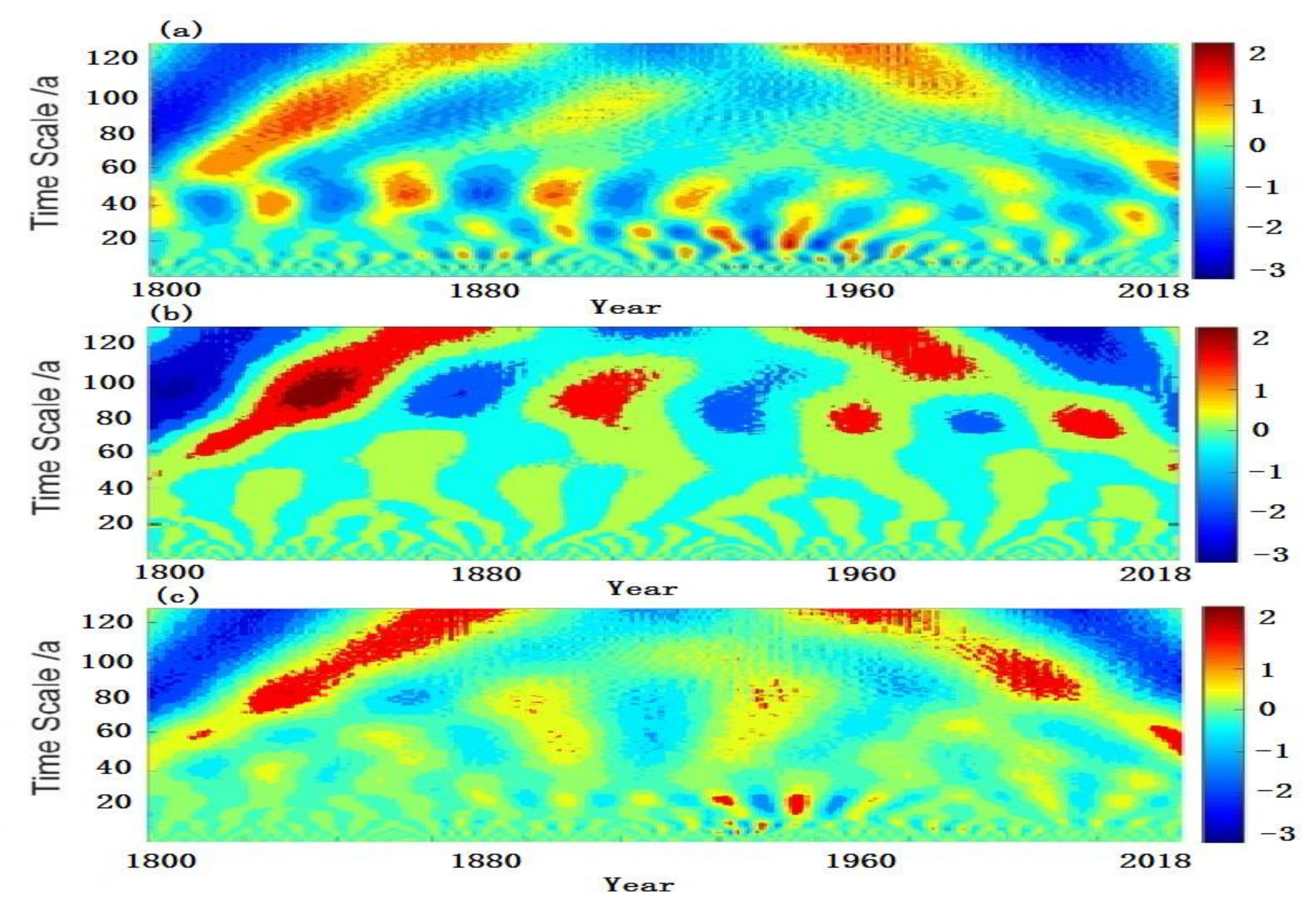
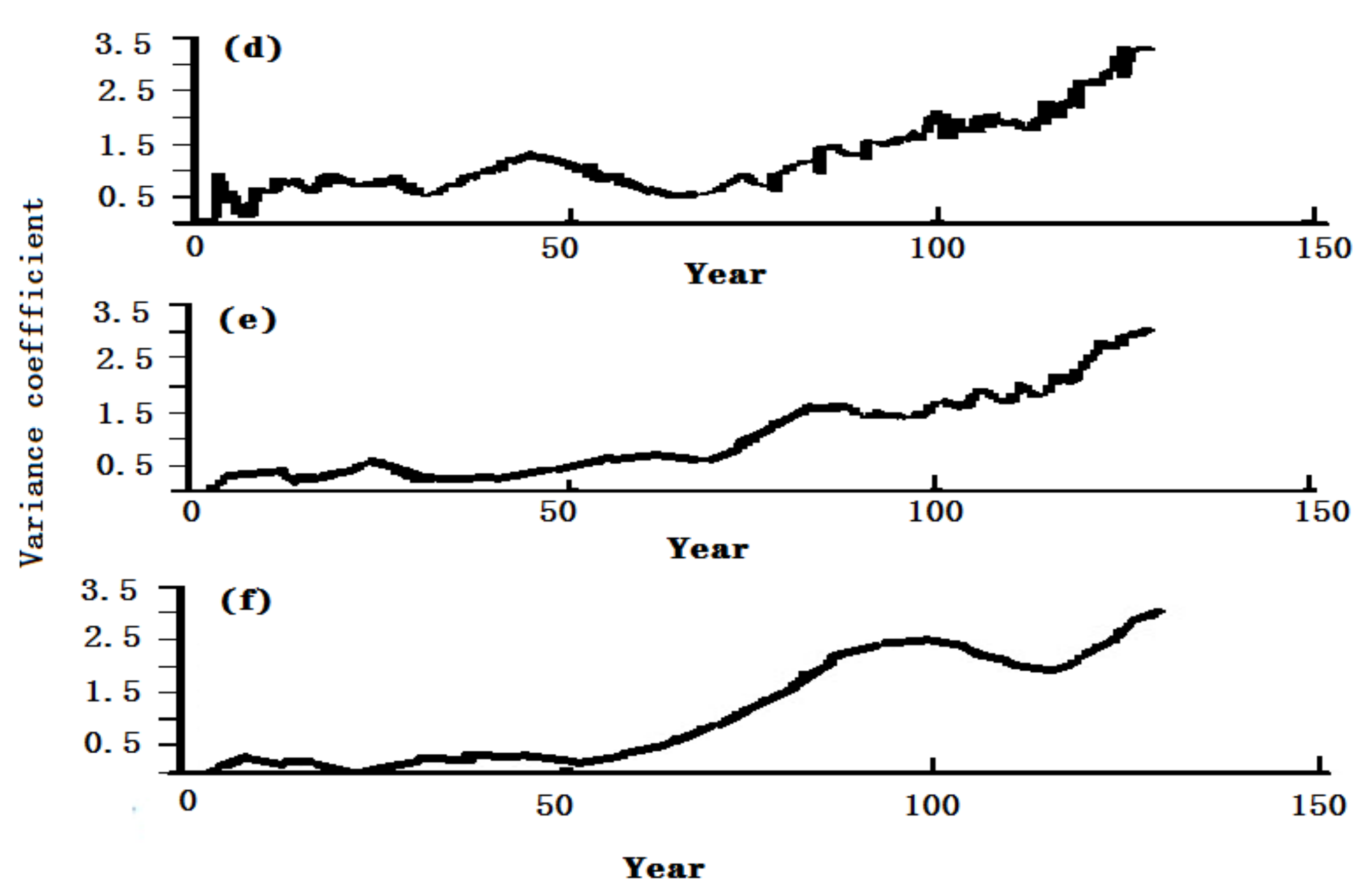

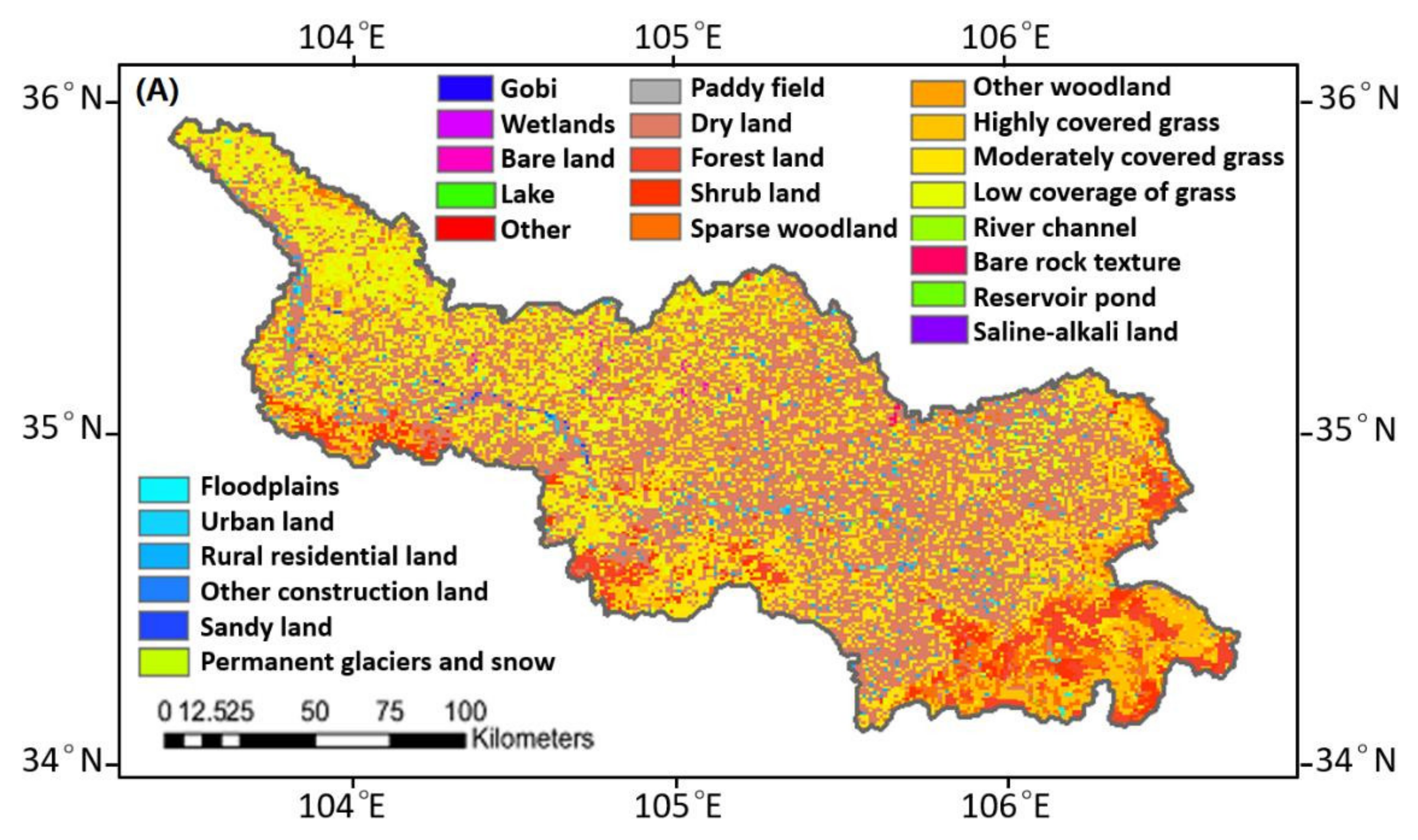
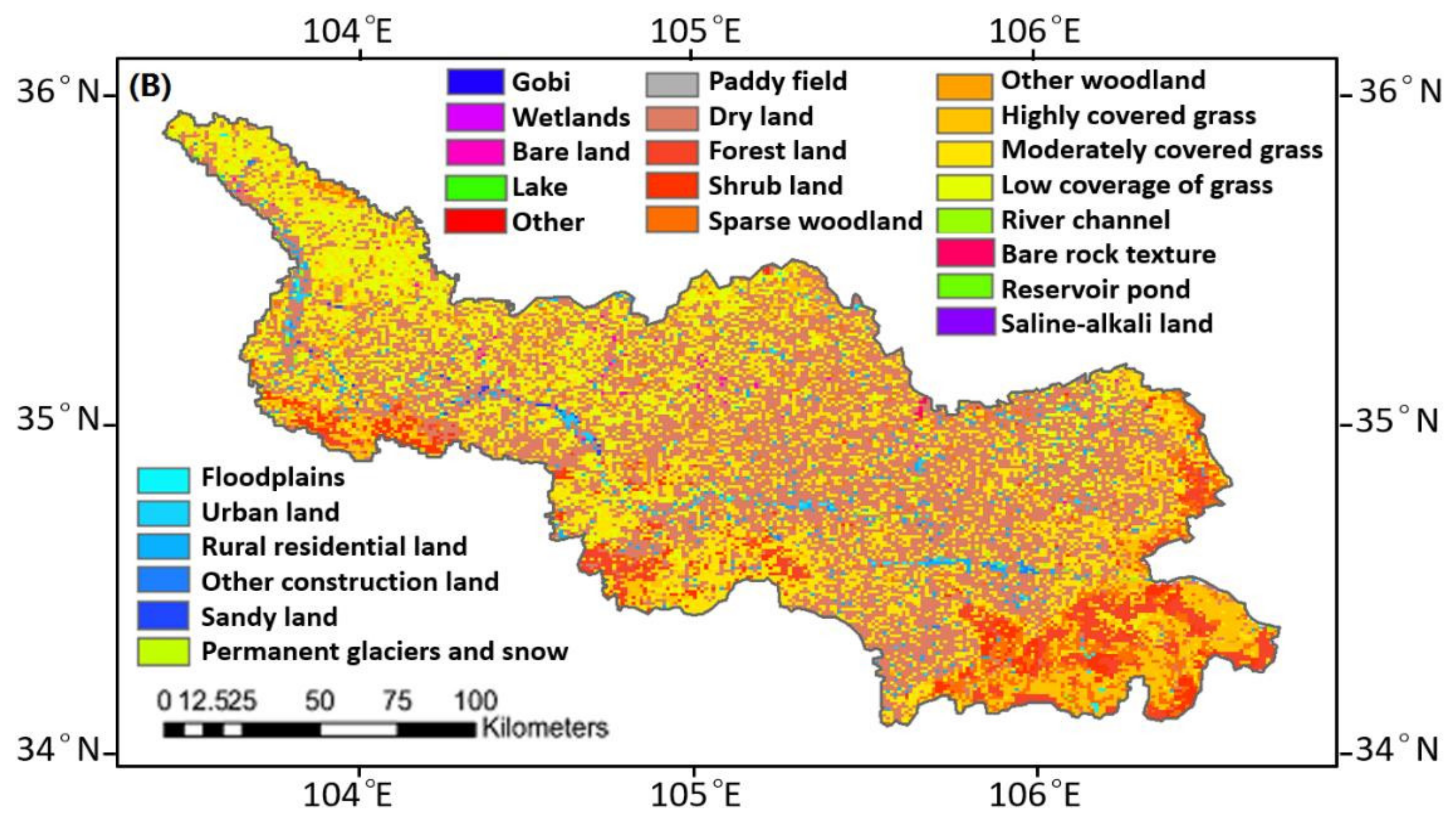

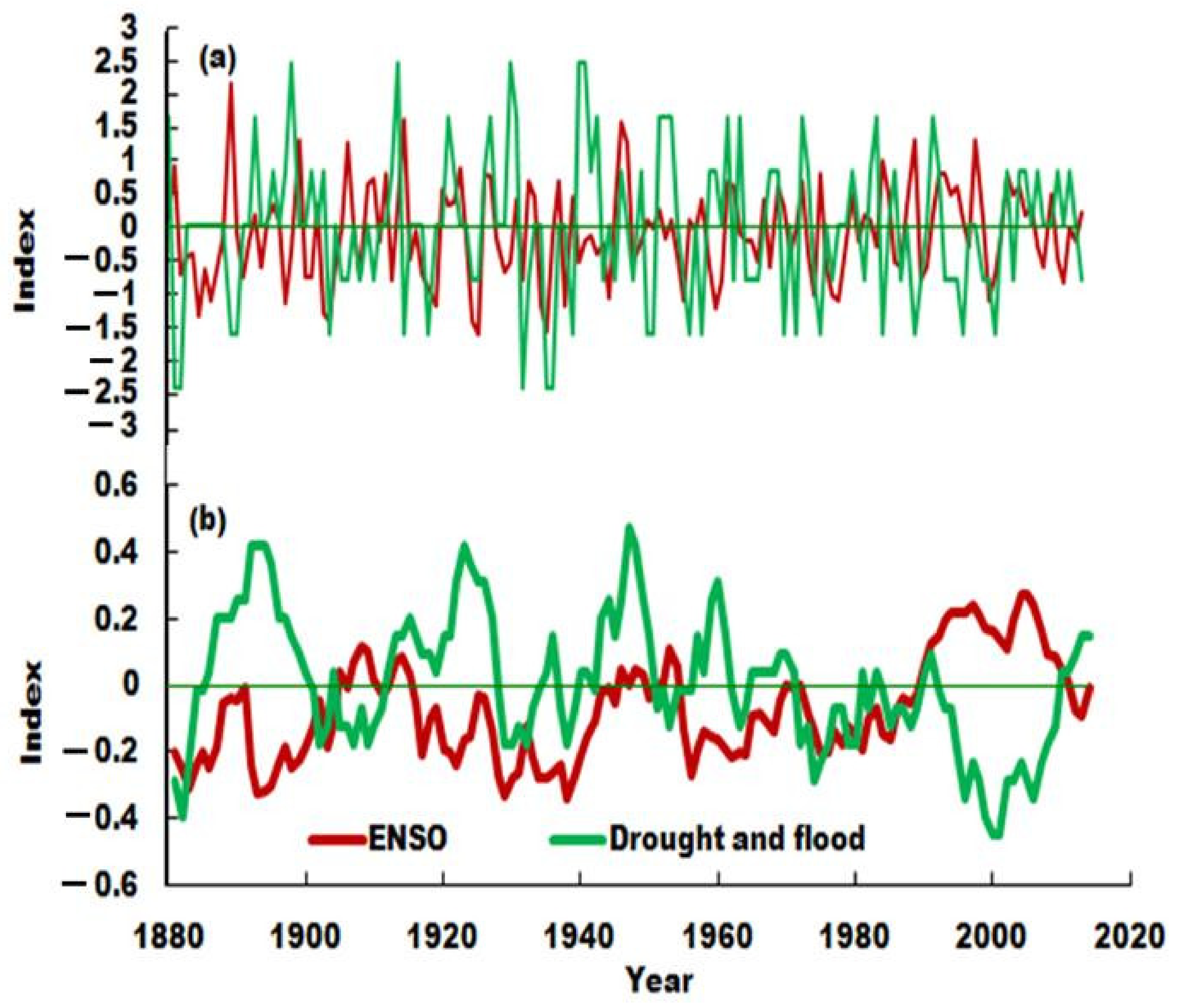
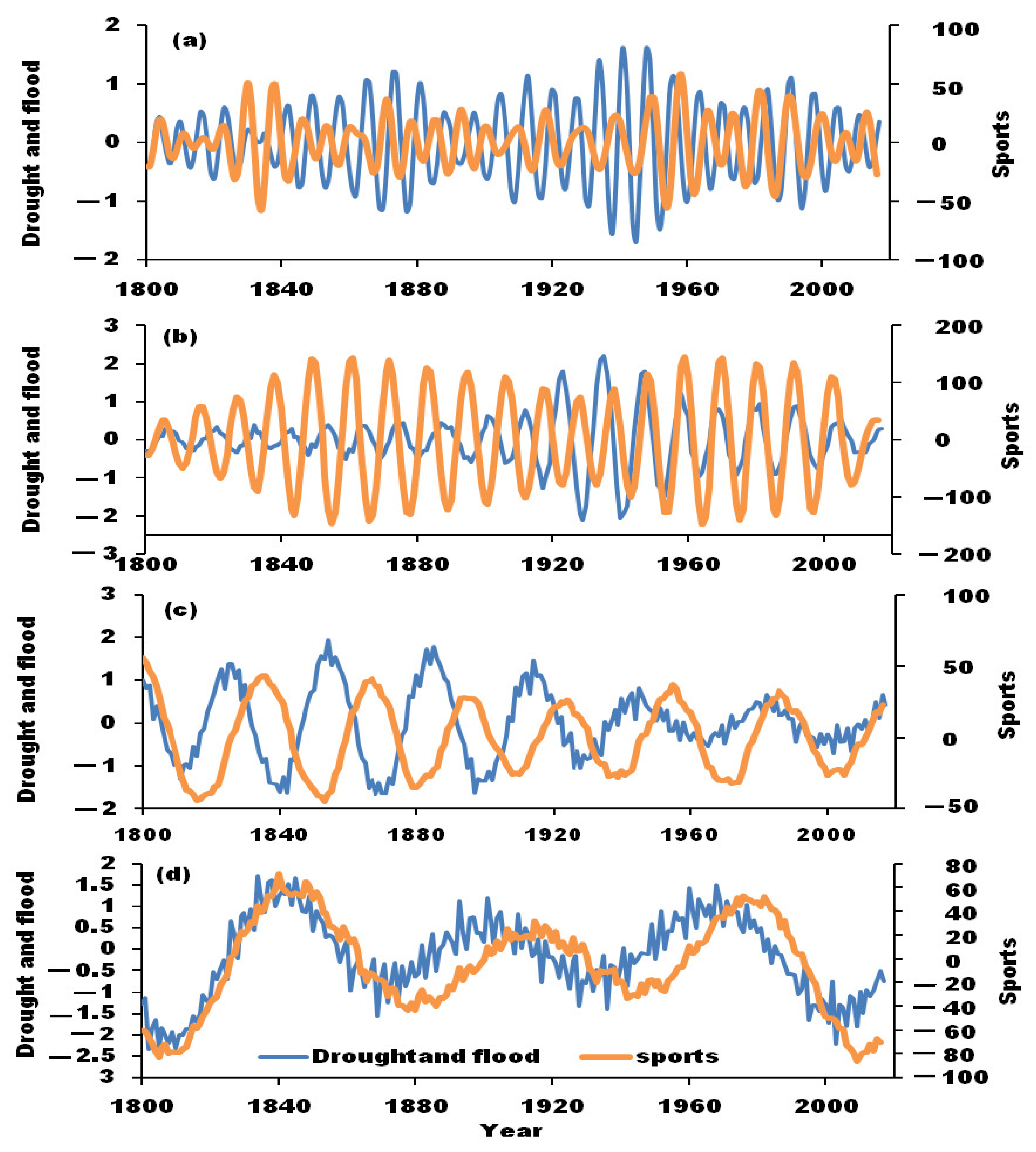
| Grade | Descriptions | Level of Droughts and Floods |
|---|---|---|
| VII | Heavy rains in many places have led to farmland flooding and river flooding | Extreme flood |
| VI | Continued rains and the rains caused water stagnation, sudden mountain torrents, and river dam collapse, thus destroying farmland and causing soaring food prices. | Big flood |
| V | The rains did not damage the residential houses. In addition, it showed less impact on crops and people’s production and life. | Flood |
| IV | No drought or disaster was recorded. | Normal |
| III | Slight lag or delay of rain which slightly impacted on crops. | Drought |
| II | No precipitation in successive months, which caused the river to dry up, and food prices to rise. | Big drought |
| I | There was no precipitation in a wide range of quarters, which caused crops to fail. | Extreme drought |
| Period | Extreme and Big Drought Years | Extreme and Big Flood Years | Drought/Flood Alternate Years | Continuous Drought Years | Continuous Flood Years | Number of Droughts/Floods |
|---|---|---|---|---|---|---|
| 1800–1834 | 1803,1823,1824 | 1823,1824 | 0/3 | |||
| 1835–1862 | 1836,1840,1861 | 3/0 | ||||
| 1863–1885 | 1868,1869,1877,1878 | 1867,1881 | 1867,1868 | 1868,1869,1877,1878 | 4/2 | |
| 1886–1902 | 1893 | 1887 | 1/1 | |||
| 1903–1923 | 1905,1909 | 1904,1912,1919, 1922,1923 | 1904,1905 | 1922,1923 | 2/5 | |
| 1924–1932 | 1924,1928,1929 | 1929,1929 | 3/0 | |||
| 1933–1943 | 1933,1934,1936 | 1933,1934 | 3/0 | |||
| 1944–1983 | 1944,1945,1951,1953 1966,1968,1992 | 1946,1947,1957,1959 1972,1981 | 1981,1982 | 1944,1945 | 1946,1947 | 7/6 |
| 1984–2008 | 1987,1995,2000 | 1990 | 3/1 |
Publisher’s Note: MDPI stays neutral with regard to jurisdictional claims in published maps and institutional affiliations. |
© 2022 by the authors. Licensee MDPI, Basel, Switzerland. This article is an open access article distributed under the terms and conditions of the Creative Commons Attribution (CC BY) license (https://creativecommons.org/licenses/by/4.0/).
Share and Cite
Liu, Y.; Wen, Y.; Zhao, Y.; Hu, H. Analysis of Drought and Flood Variations on a 200-Year Scale Based on Historical Environmental Information in Western China. Int. J. Environ. Res. Public Health 2022, 19, 2771. https://doi.org/10.3390/ijerph19052771
Liu Y, Wen Y, Zhao Y, Hu H. Analysis of Drought and Flood Variations on a 200-Year Scale Based on Historical Environmental Information in Western China. International Journal of Environmental Research and Public Health. 2022; 19(5):2771. https://doi.org/10.3390/ijerph19052771
Chicago/Turabian StyleLiu, Yinge, Yanjun Wen, Yaqian Zhao, and Haonan Hu. 2022. "Analysis of Drought and Flood Variations on a 200-Year Scale Based on Historical Environmental Information in Western China" International Journal of Environmental Research and Public Health 19, no. 5: 2771. https://doi.org/10.3390/ijerph19052771
APA StyleLiu, Y., Wen, Y., Zhao, Y., & Hu, H. (2022). Analysis of Drought and Flood Variations on a 200-Year Scale Based on Historical Environmental Information in Western China. International Journal of Environmental Research and Public Health, 19(5), 2771. https://doi.org/10.3390/ijerph19052771







